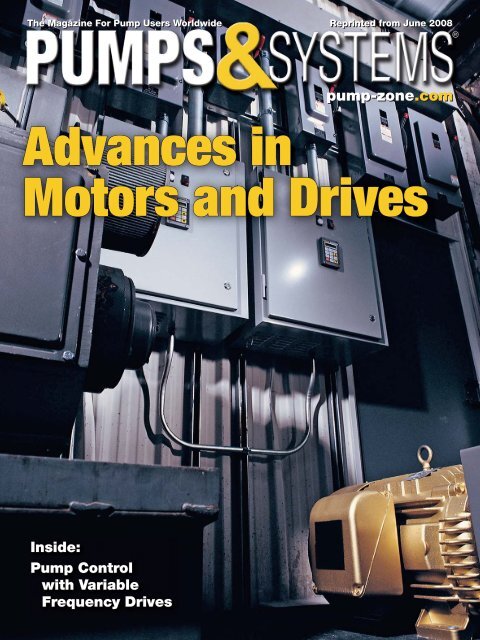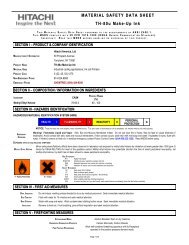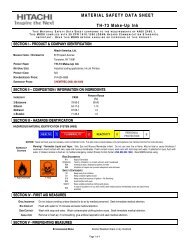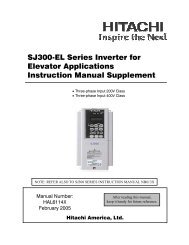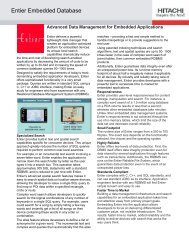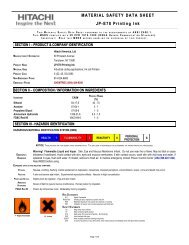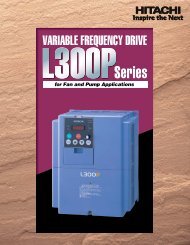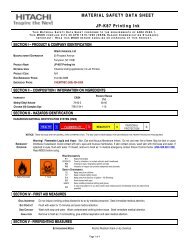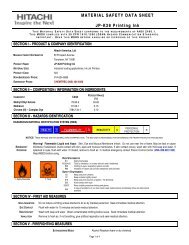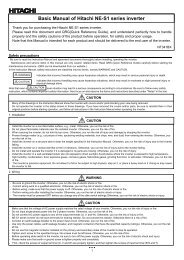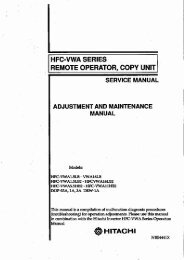Pump Control with Variable Frequency Drives - Hitachi America, Ltd.
Pump Control with Variable Frequency Drives - Hitachi America, Ltd.
Pump Control with Variable Frequency Drives - Hitachi America, Ltd.
- No tags were found...
You also want an ePaper? Increase the reach of your titles
YUMPU automatically turns print PDFs into web optimized ePapers that Google loves.
The Magazine For <strong>Pump</strong> Users Worldwide Reprinted from June 2008pump-zone.comAdvances inMotors and <strong>Drives</strong>Inside:<strong>Pump</strong> <strong>Control</strong><strong>with</strong> <strong>Variable</strong><strong>Frequency</strong> <strong>Drives</strong>
Advances in Drive Technology<strong>Pump</strong> <strong>Control</strong> <strong>with</strong><strong>Variable</strong> <strong>Frequency</strong><strong>Drives</strong>Kevin Tory, <strong>Hitachi</strong> <strong>America</strong>, <strong>Ltd</strong>.Why pump control <strong>with</strong> variable frequency drives may bethe most sensible approach to energy savings.While driving a car <strong>with</strong> the gas pedal to the floor andthen controlling your speed using the brake is obviouslyinefficient, many facilities use the approachfor pump control. Flow control <strong>with</strong> throttling or restrictivedevices sacrifices energy efficiency and results in unnecessarycosts. However, <strong>with</strong> an understanding of basic principles, ananalysis of the specific application, information about availablecontrol solutions and evaluation of technologically advancedequipment, facilities can make a quantum leap in improvingthe efficiency and economy of pumping operations.The BasicsEnergy efficiency starts <strong>with</strong> motor speed control. Sixtyfivepercent of all electrical energy used in the United Statesoperates flow loads such as pumps, fans, blowers and compressors,mostly powered by constant speed induction motors.When output flow requirements fluctuate in such systems, anexternal means of adjustment is needed.Commonly used methods for flow control include throttlingor restrictive devices such as valves, outlet dampers, inletvanes and diffusers. Mechanical speed changers and recirculatingsystems are also sometimes used. However, all these deviceswaste energy, dissipate power by friction and diffuse heat.Fixed-speed pumps draw nearly full horsepower and consumenearly maximum energy full time, regardless of demand.Power requirements for throttled systems drop only slightlyeven when flow or volume is reduced significantly.<strong>Variable</strong> speed devices such as belts, gears, magneticFigure 1. <strong>Variable</strong> frequency drives permitusers to consume the least amount of powerto obtain desired pressure and flow. Figure 22 JUNE 2008 www.pump-zone.com a PUMPS & SYSTEMS reprint
clutches and hydraulic drives accomplish this function mechanically, but they arecostly, bulky, waste power and require high maintenance.DC adjustable speed drives can provide speed variation. However, DC motorsare two to three times the cost of an equivalent-rated AC motor. DC motors arealso larger, heavier, require more maintenance and are more difficult to operate inchallenging environments.<strong>Variable</strong> frequency control of AC induction motors provides an economicallysound and operationally effective solution for speed control and reduced powerconsumption. It can also be made responsive to signals from flow sensors, programmablecontrollers and other control systems. Microprocessor-based AC motorcontrol affords users options that can provide short- and long-term productivityand profitability improvements.Curves Determine Centrifugal <strong>Pump</strong> EfficiencyIn-line valves are often used to regulate flow or pressure in liquid pumping systems.The valve can be a significant source of energy loss by causing a restriction in theflow path, thus increasing the pressure. An AC drive provides more efficient flowcontrol by varying the pump motor speed. By comparing the energy requirementsand costs when a throttling device is used for flow control on a centrifugal pump<strong>with</strong> the power used when an variable frequency drive (VFD) is used to control thesame flow, the potential savings become evident.The first step is to determine the theoretical load requirements and potentialenergy savings for the specific application using three interrelated Affinity Laws.• Reduced speed reduces flow or volume proportionally. Since flow varies linearly<strong>with</strong> speed, a 50 percent decrease in speed means a 50 percent decrease in flow.• Pressure or head varies as the square of speed. At 50 percent speed, there is 50percent flow, but only 25 percent pressure.• Power requirements vary as the cube of speed. At 50 percent speed, there is 50percent flow and 25 percent pressure, but only 12.5 percent power.The second step is to define the pump system curve. Typical characteristics ofa pump system are:• Static head of lift, which is the height the fluid must be lifted from the sourceto the outlet.• Friction head, which is power loss caused by the flow of the fluid through thepipe, valves, bends and any other device in the piping. This non-linear loss isdependent on flow.Adding the two heads together creates the system curve, which describes whatflow will occur given a specific pressure. Knowing the system curve, the pumpmanufacturer can select an impeller size to meet the flow requirements specified.The point where the pump curve and the system curve cross determines theoperating point of the system. This system will have only one operating point, soif variable flow is required, something needs to be added.Flow <strong>Control</strong>Not all options are created equal. The typical technique for flow control is the useof a throttling valve. Partially closing the valve adds another restriction, raising thesystem losses and the system curve. The flow rate will now be determined by thepoint where the new system curve crosses the pump curve. The amount of energy thesystem consumes to do this is proportional to the head pressure and the flow rate.a PUMPS & SYSTEMS reprint www.pump-zone.com JUNE 2008 3


